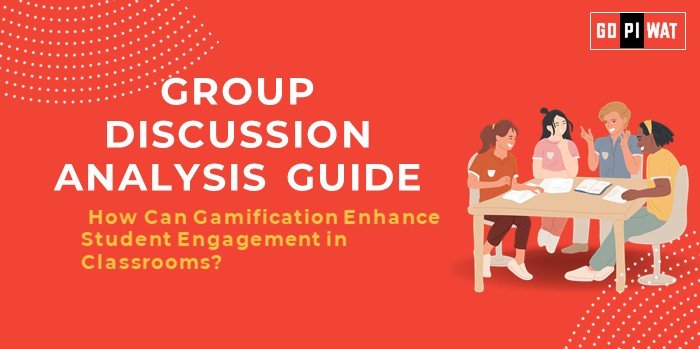📋 WAT/Essay Analysis Guide: How Can Gamification Enhance Student Engagement in Classrooms?
🌐 Understanding Gamification’s Importance
Gamification in classrooms is revolutionizing education by merging entertainment with learning, appealing to students’ intrinsic and extrinsic motivations. Its focus on engagement aligns with broader themes in education, such as technology integration and personalized learning.
⏳ Effective Planning and Writing
- 📝 Time Allocation:
- ⏳ Outline: 5 minutes
- ✍️ Writing: 20 minutes
- 🔍 Review: 5 minutes
- 📊 Preparation Tips: Research key gamification tools (e.g., Classcraft, Kahoot!), identify benefits (e.g., retention improvement), and understand implementation barriers.
🖊️ Introduction Techniques for Essays
- 🔀 Contrast Approach: “Despite widespread advancements in educational technology, traditional teaching methods often fail to engage digital-native students. Gamification bridges this gap by transforming lessons into captivating experiences.”
- 💡 Solution-Based Approach: “Gamification addresses the pressing challenge of declining student motivation, offering innovative ways to make learning interactive and rewarding.”
🗂️ Structuring the Essay Body
🏆 Achievements
- 🎮 Improved Engagement: Tools like Kahoot! and Classcraft show a 40% rise in classroom participation and retention rates.
- 📈 Real-World Success: Case studies indicate gamified lessons improve knowledge retention by integrating rewards, competition, and interactive challenges.
- 🧠 Motivation: Gamification taps into students’ intrinsic and extrinsic motivations through progress points, leaderboards, and real-time feedback.
⚠️ Challenges with Comparative Analysis
- 🌐 Digital Divide: In developing countries, limited access to technology creates disparities, reducing the effectiveness of gamified tools.
- 💰 Cost Barriers: Implementing advanced gamification platforms may strain budgets in underfunded schools.
- ⚖️ Over-Gamification: Excessive reliance on rewards can shift focus from deep learning to mere competition.
🔮 Future Outlook
- ✨ Emerging Trends: AI-driven gamification tools can personalize learning experiences based on students’ strengths and weaknesses.
- 🏛️ Policy Recommendations: Governments must invest in digital infrastructure to ensure equitable access to gamified learning tools globally.
- 🚀 Classrooms of the Future: Virtual reality (VR) and augmented reality (AR) will redefine gamified education, making lessons immersive and experiential.
🗯️ Concluding Effectively
⚖️ Balanced Conclusion
“Gamification, while not a panacea, represents a powerful tool for fostering engagement and retention. Addressing accessibility concerns will ensure its success for all students.”
🌐 Future-Focused Conclusion
“As education evolves, gamification offers a glimpse into the classroom of the future, where learning is as engaging as playing a video game.”
✍️ Sample Short Essays
⚖️ Balanced Perspective
“Gamification has revolutionized education by engaging students through points, rewards, and competition. However, its success hinges on addressing challenges such as cost and accessibility to ensure inclusive benefits.”
💡 Solution-Oriented
“To sustain student engagement, gamification offers a strategic solution by blending technology with pedagogy. Policymakers must prioritize investments in equitable digital access to realize its full potential.”
🌍 Global Comparison
“While countries like Finland excel in gamified learning, others lag due to infrastructure gaps. Bridging this divide will ensure global education benefits from this innovative tool.”
🚀 Key Takeaways for Structured Discussions
- 🔍 Achievements: Enhanced engagement, improved retention, and personalized learning through tools like Kahoot! and Classcraft.
- ⚠️ Challenges: The digital divide, cost barriers, and risk of over-gamification.
- ✨ Future Outlook: AI-driven gamification and VR/AR tools can make classrooms interactive and inclusive.


